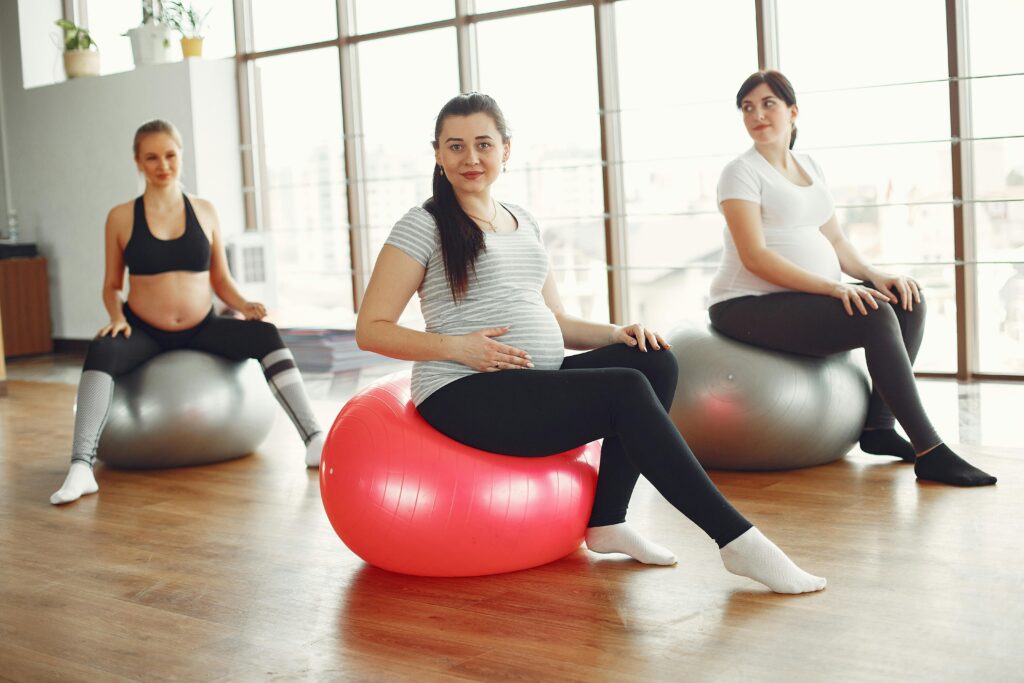A magnificent journey, pregnancy brings with it many physical and emotional changes. Keeping up a regular fitness regimen can help mom and baby in many ways during these transitions. To guarantee safety and efficacy, exercise during pregnancy must be carefully considered and modified. We will explore the benefits of prenatal exercise, the kinds of workouts that are safe for expectant mothers, safety precautions, and professional advice to assist expectant mothers confidently embark on their fitness path in this extensive book.
The Importance of Exercise During Pregnancy
Better cardiovascular health: Frequent exercise during pregnancy improves circulation, fortifies the heart, and raises cardiovascular health in general. This guarantees that the developing fetus has an adequate quantity of oxygen and nutrients, which is vital for the mother’s health as well as the baby’s development.
Improved mental health and mood: Hormonal shifts and emotional ups and downs are common side effects of pregnancy. Endorphins, sometimes known as “feel-good” hormones, are released when exercise is performed and have the potential to reduce tension, anxiety, and depressive symptoms. It encourages emotional equilibrium and a sense of well-being, which makes pregnancy more enjoyable.
Enhanced energy: Frequent exercise can actually boost energy levels, even in spite of the inherent exhaustion that comes with pregnancy. Exercise can help fight sluggishness and enhance vitality throughout the day by enhancing circulation, boosting metabolism, and delivering oxygen and nutrients to tissues.
Improved posture and less discomfort: Keeping proper posture becomes more crucial as the body changes significantly to support the growing baby. Exercise relieves tension and discomfort by strengthening the muscles that support the pelvis and spine. Expectant moms can lessen pelvic pain, back pain, and other common pregnancy-related discomforts by aligning their bodies better.
Getting ready for labor and delivery: These processes call for fortitude, perseverance, and strength. Prenatal yoga, pelvic floor exercises, and mild aerobic training are a few of the exercises that might help the body be ready for the demands of childbirth. In example, strengthening the pelvic floor muscles can help push during delivery and lower the chance of postpartum urine incontinence. As they get closer to giving birth, pregnant moms can feel more strong and self-assured by including these exercises into their routine.

Safe Exercises to Do While Pregnant
Walking: Easily incorporated into daily life, walking is a low-impact activity. It is the best option for pregnant women of all fitness levels because it boosts the cardiovascular system without straining the joints. Walking is a safe and efficient way to be active throughout pregnancy, whether you choose to walk briskly on the treadmill or take a leisurely stroll outside.
Swimming: Water aerobics and swimming provide a full-body workout with a low chance of damage. The weight of the expanding tummy is supported by the buoyancy of the water, which eases pressure on the spine and joints. In addition, the resistance offered by the water helps to build muscle without taxing the body. Swimming helps pregnant women who are experiencing back pain, swelling, or discomfort because it eases stress and encourages relaxation.
Prenatal yoga: Specifically designed to meet the needs of pregnant moms, prenatal yoga focuses on gentle stretching, strengthening, and relaxation practices. It promotes body awareness, mindfulness, and deep breathing, which has positive effects on the body and the mind throughout pregnancy. Prenatal yoga sessions are accessible to women at all stages of pregnancy because they frequently include adjustments and supports to accommodate the developing body. Regular prenatal yoga practice can help expectant mothers become more flexible, less stressed, and mentally and physically ready for childbirth.
Low-impact aerobics: Activities that reduce impact on the joints, such dancing, stationary cycling, or utilizing an elliptical machine, can help sustain cardiovascular fitness. Engaging in these activities can raise heart rate, enhance circulation, and build endurance—all of which are advantageous during pregnancy. Low-impact aerobics are a flexible and pleasurable choice for pregnant moms who want to maintain an active lifestyle since they can be customized to meet individual fitness goals and tastes.
Strength training: During pregnancy, maintaining muscular tone and strength can be achieved with strength training using bodyweight exercises, resistance bands, or light weights. It works the main muscular groups—the arms, legs, back, and core—to increase functional strength and general fitness. By enhancing posture and alignment, strength training can also help reduce pregnancy-related discomforts such back pain and pelvic instability. Expectant mothers can support their developing bodies and get ready for the physical demands of labor and motherhood by including strength training activities in their routine.

Safety Recommendations for Working Out While Expectant
Speak with your medical professional: See your obstetrician or midwife before starting any kind of workout regimen while you are pregnant. Since every pregnancy is different, your healthcare professional can provide tailored guidance based on your health history, present condition, and any particular concerns. They can offer advice on how to adjust your routine as needed during your pregnancy and assist assess whether particular forms of exercise are safe for you and your unborn child.
Pay attention to your body: Your body changes significantly throughout pregnancy, so it’s important to pay special attention to the signs it sends when exercising. It’s critical to stop exercising right away and take a break if you feel any pain, discomfort, dizziness, or shortness of breath. Trying to push through discomfort could make things worse or lead to injuries. Rather, pay attention to what your body requires and modify the intensity or activity of your workout as needed. Keep in mind that throughout pregnancy, safety and wellbeing should come first. This is not the time to push yourself.
Remain hydrated: While staying hydrated is important for everyone, pregnant women especially need to pay close attention to this because their bodies require more fluids. Drinking lots of water before, during, and after exercise is crucial since dehydration can cause exhaustion, hyperthermia, and even contractions. Throughout the day, try to sip water frequently, especially if you’re exercising. Use extra caution to stay cool and hydrated when exercising outside or in hot weather. Some of these measures include wearing lightweight, breathable clothing and avoiding the hottest parts of the day.
Steer clear of overheating: Being pregnant makes you more susceptible to the heat, and it can be dangerous for both you and your unborn child. It’s important to exercise in well-ventilated spaces and to steer clear of activities that cause your body temperature to rise too high. To reduce the chance of overheating, use air-conditioned indoor exercises or exercise at cooler times of the day. Take prompt action to cool down, such as resting in a shady area and drinking water, if you notice any symptoms of overheating, such as heavy sweating, lightheadedness, or fainting.
Adjust as necessary: Your body will change physically as your pregnancy goes on, so you might need to adjust your workout schedule. It’s critical to pay attention to your body and modify your exercise regimen as necessary. After the first trimester, stay away from exercises that require you to lie flat on your back as this position can compress important blood vessels and decrease blood supply to the uterus. Choose side-lying postures or activities that require you to remain upright or on all fours instead. To further lower the chance of injury, think about altering high-impact exercises or activities that place undue strain on the joints.

Professional Advice on Safe Pregnancy Exercise
Warm up and cool down: It’s important to warm up your muscles and get your body ready for physical activity before beginning any exercise program. A good warm-up improves flexibility, lowers the chance of injury, and promotes blood flow to the muscles. Dynamic stretches, walking, or marching in place are examples of gentle exercises that can help release tight muscles and joints. In a similar vein, cooling down after an exercise permits your breathing and heart rate to gradually return to normal. To encourage relaxation and avoid muscle discomfort, incorporate deep breathing exercises and gentle stretches.
Pay attention to form: Keeping your posture and alignment correct is essential for avoiding injuries and getting the most out of your workouts, especially while you’re expecting. During workouts, be mindful of your body mechanics and make sure you’re using good form. To support your expanding tummy and safeguard your lower back, contract your core muscles. Choose motions that feel solid and comfortable, and steer clear of activities that put strain on your back or pelvis. Consider working with a trained prenatal exercise instructor who can offer advice and corrections if you’re not sure about proper form.
Include pelvic floor exercises: The muscles of the pelvic floor are essential for supporting the pelvic organs, managing bowel and bladder movements, and easing childbirth. These muscles experience major changes during pregnancy as a result of the uterus’s increased weight and hormonal shifts. Kegel exercises and other pelvic floor exercises can help tone and strengthen these muscles, which lowers the risk of pelvic floor dysfunction and urine incontinence. As you do sets of contractions and relaxations, progressively increase the duration and intensity as tolerated to incorporate pelvic floor exercises into your daily routine.
Pay attention to your pelvic girdle: Pregnancy puts more stress and pressure on the pelvic girdle, which is made up of the pelvis and the ligaments and muscles that surround it. Pelvic pain, instability, and discomfort can be attributed to hormonal fluctuations and the expanding uterus. Exercises that increase pelvic girdle pain should be avoided, such as deep squats, lunges, and high-impact sports. Rather, go for low-impact activities that provide pelvic support and stability, such walking, swimming, or prenatal yoga. If you have pelvic pain or discomfort when exercising, try to avoid or adjust the activities that make your symptoms worse. You should also seek advice from your healthcare professional.
Look for expert advice: Being pregnant is a special and life-changing experience, and exercising safely at this time calls for knowledge and caution. Think about collaborating with a personal trainer or licensed prenatal fitness teacher who has worked with expectant clients. They are able to customize a safe and efficient workout regimen to fit your fitness level, goals, and specific demands. An experienced teacher may offer advice on how to perform exercises safely and effectively during your pregnancy, including how to modify your form and pick the right intensity levels. They can also provide encouragement, support, and inspiration, which will help you stick to your fitness objectives and have a happy, active pregnancy.

Pregnancy-related exercise has numerous advantages for both the mother and the unborn child, including bettering mood, improving cardiovascular health, boosting energy, improving posture, and preparing the body for labor and delivery. Pregnant women can continue to lead an active and healthy lifestyle by selecting safe and appropriate workouts, adhering to important safety regulations, and utilizing professional advice. Workout during pregnancy can help make things go more smoothly, make labor easier, and hasten the healing process after giving birth if done under the right supervision and care. Prior to beginning any fitness program, remember to pay attention to your body, remain hydrated, and speak with your healthcare professional. Pregnancy can be a time of strength, vitality, and well-being if it is approached with focus and attention.


